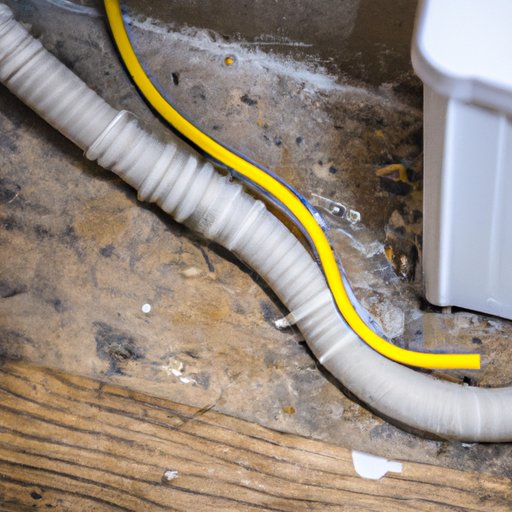
Introduction
As the summer season arrives, air conditioning units become an essential part of home maintenance. However, if your AC drain line becomes clogged, it can lead to significant problems, including mold growth, water damage, and costly repairs. This article will guide you through the process of cleaning your AC drain line and provide tips for maintaining it throughout the year.
Step-by-Step Guide to Cleaning Your AC Drain Line
Before we begin, it’s essential to ensure your safety by turning off the AC unit before starting the cleaning process. Find the circuit breaker that connects to your AC unit and switch it off.
Next, locate the AC drain line, typically located near the outdoor unit or the attic. It’s usually a PVC pipe that is white or black and measures 3/4 to 1-inch in diameter.
Determine how clogged the drain line is by performing a visual inspection, running water through it, and checking for water leaks. If the pipe is covered in algae or other obstructions, there are different methods you can use to clean it.
If the clog is minor, you can use a wet/dry vacuum to powerful suction forces to remove debris from the drain pipe. This method is easy to execute. Alternatively, you may use a pipe cleaner to manually remove visible blockages.
If the clog is severe, you may need to use a condensate pump to remove the blockage. The pump can be accessed by cutting the PVC pipe and installing the pump in-line with the pipe.
After cleaning, it’s time to restart your AC unit. Turn it on and see if cool air is coming out of the vents. If not, it is a sign that the drain line is still clogged, and you need to repeat the cleaning process.
DIY Cleaning Methods for AC Drain Line
DIY cleaning methods can save you money and time. Cleaning with vinegar is an eco-friendly way to clear the gunk from an AC drain line. Mix equal parts vinegar and water and pour the solution into the drain line. Leave it for 30 minutes before flushing it with water. Baking soda also has cleaning properties. Mix it with hot water and allow it to sit in the drain line for a few minutes. Finally, flush the pipe with water. Bleach is another option. Again, mix it with hot water and pour the solution into the AC drain line. Leave it for 15 minutes before flushing the pipe with water.
Importance of Regularly Cleaning Your AC Drain Line
Failure to clean your AC drain line can lead to major problems. Clogged drains lead to mold growth and poor air quality that can affect your family’s health. It can lead to costly repairs to fix water damage and mold remediation. Therefore, it’s crucial to make cleaning your drain line a part of your regular maintenance routine.
When to Clean Your AC Drain Line
Several signs indicate that it may be time to clean your AC drain line. If there is standing water near the drain pipe, it is a clear indication of a clog. If the air conditioner is not cooling, the tonnage might be lower than what your house requires, or the AC drain pipe could be clogged. Unpleasant odors coming from the vents can also be an indicator of mold growth due to clogged pipes. Finally, if water stains or discolorations are appearing in the ceiling or walls near the AC unit, it means there is a problem with your drain line.
To ensure optimal maintenance, cleaning your AC drain line every three to six months is ideal.
Tools You Need for Cleaning Your AC Drain Line
Some essential tools for cleaning your AC drain line include a wet/dry vacuum, pipe cleaner, or condensate pump. When using a pipe cleaner, make sure it’s long enough to reach the clogged area. You may also need additional tools depending on how difficult it is to access the drain pipe, such as a hacksaw or plumber’s tape.
Tips for Preventive Maintenance
Preventive maintenance can help avoid clogged AC drain lines. Some tips include checking and cleaning air filters regularly, inspecting refrigerant levels, and scheduling an annual AC tune-up. Make sure the outdoor unit is free of debris and vegetation. Moreover, regular inspections are essential for early detection of clogs and other AC problems.
Conclusion
Ensuring optimal AC maintenance requires paying attention to the drain line. If left unchecked, a clogged drain line can have severe consequences. Utilizing this step-by-step guide for ac drain cleaning and implementing DIY cleaning methods can help prevent clogs and keep your AC unit functioning optimally. Remember, prevention is always the best medicine for AC maintenance.




